 |
 |
 |
 |
 |


 |
|
 |
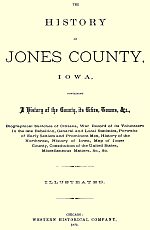
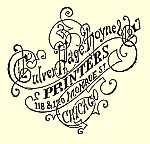


|
|
SCOTCH GROVE TOWNSHIP
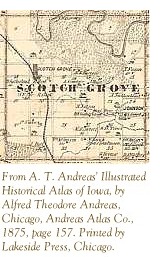 The The first settlement in this township was made in 1836 or 1837, and, consequently, Scotch Grove is one of the very earliest settled districts in the county. The first settlers were Scotch emigrants from the Selkirk settlements, in British America, on the Red River of the North. They are said to have traveled the whole distance in ox-carts of the most antiquated style of construction. The hardships and privations incident to their journey-nearly a thousand miles-were numerous, and such as must have tried the very souls of these hardy pioneers to an extent that entitles them to the everlasting respect of all who now enjoy the advantages of this rich and populous district of the county of Jones. The indomitable will and courageous spirit of these early settlers have stamped their impress upon the character of the district in which they located, that will continue to be felt for a long time to come. The honor that is justly their due has never been paid to them, and the passing notice we give to them is by no means commensurate with their just deserts. first settlement in this township was made in 1836 or 1837, and, consequently, Scotch Grove is one of the very earliest settled districts in the county. The first settlers were Scotch emigrants from the Selkirk settlements, in British America, on the Red River of the North. They are said to have traveled the whole distance in ox-carts of the most antiquated style of construction. The hardships and privations incident to their journey-nearly a thousand miles-were numerous, and such as must have tried the very souls of these hardy pioneers to an extent that entitles them to the everlasting respect of all who now enjoy the advantages of this rich and populous district of the county of Jones. The indomitable will and courageous spirit of these early settlers have stamped their impress upon the character of the district in which they located, that will continue to be felt for a long time to come. The honor that is justly their due has never been paid to them, and the passing notice we give to them is by no means commensurate with their just deserts.
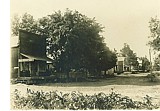  The first settlers were John and Alexander Sutherland, Joseph Bremner, Alexander McLlain and David McCoy. After these came Ebenezer Sutherland, Donald Sutherland and Donald Sinclair, who came in about 1838. Donald Livingston came in 1840, and settled near what is now the poor farm on the west side of Scotch Grove. About 1843, M. H. Hutton, and, somewhat later, L. J. Dreibelbis and Mathew Dawson settled in the township. In 1841, John E. Lovejoy, who had settled in Clay Township in 1839, came into Scotch Grove, and is still a resident, though he has at times been a resident of other portions of the country for a time, and was, for three years and a half, Consul to Peru, under the appointment of President Lincoln. The first settlers were John and Alexander Sutherland, Joseph Bremner, Alexander McLlain and David McCoy. After these came Ebenezer Sutherland, Donald Sutherland and Donald Sinclair, who came in about 1838. Donald Livingston came in 1840, and settled near what is now the poor farm on the west side of Scotch Grove. About 1843, M. H. Hutton, and, somewhat later, L. J. Dreibelbis and Mathew Dawson settled in the township. In 1841, John E. Lovejoy, who had settled in Clay Township in 1839, came into Scotch Grove, and is still a resident, though he has at times been a resident of other portions of the country for a time, and was, for three years and a half, Consul to Peru, under the appointment of President Lincoln.
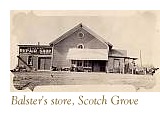  At the time of the first settlement, there were no houses between the military road and Canton. The nearest market was Dubuque, and the nearest mill at Catfish Creek, and was a very poor excuse for a mill at that. The places now called cities were almost without inhabitant. Maquoketa had a few settlers about it, and Dubuque was a mere hamlet. A few accessions were made occasionally until 1850, when some pioneers arrived from Indiana and Pennsylvania, and the spies having sent back a favorable report, others followed thick and fast, and now the township is thickly settled. Taken as a whole, it may be said that this township is unsurpassed for beauty of location by any in the county, and but few, if any, in the State. The South Fork of the Maquoketa waters the township on the north, along which there is good timber. Mineral Creek waters it in the southeast, and another small stream runs through about the center. The soil is a black, sandy loam, yielding abundantly to the cultivator, though it requires care and attention to develop its full resources. The inhabitants are, as a rule, a moral, temperate and industrious people. During the late civil war, Scotch Grove was among the first in the county to send volunteers to the front, to fight for the preservation of the Union, and she continued equally patriotic throughout the long struggle. At the time of the first settlement, there were no houses between the military road and Canton. The nearest market was Dubuque, and the nearest mill at Catfish Creek, and was a very poor excuse for a mill at that. The places now called cities were almost without inhabitant. Maquoketa had a few settlers about it, and Dubuque was a mere hamlet. A few accessions were made occasionally until 1850, when some pioneers arrived from Indiana and Pennsylvania, and the spies having sent back a favorable report, others followed thick and fast, and now the township is thickly settled. Taken as a whole, it may be said that this township is unsurpassed for beauty of location by any in the county, and but few, if any, in the State. The South Fork of the Maquoketa waters the township on the north, along which there is good timber. Mineral Creek waters it in the southeast, and another small stream runs through about the center. The soil is a black, sandy loam, yielding abundantly to the cultivator, though it requires care and attention to develop its full resources. The inhabitants are, as a rule, a moral, temperate and industrious people. During the late civil war, Scotch Grove was among the first in the county to send volunteers to the front, to fight for the preservation of the Union, and she continued equally patriotic throughout the long struggle.
 The small village of Scotch Grove is on the Davenport Branch of the Chicago, Milwaukee & St. Paul Railway, in the west part of the township. H. D. Hanna has a general store, and is also the proprietor of a flourishing creamery. The small village of Scotch Grove is on the Davenport Branch of the Chicago, Milwaukee & St. Paul Railway, in the west part of the township. H. D. Hanna has a general store, and is also the proprietor of a flourishing creamery. |
|


|
|
CHURCHES AND RED RIVER EMIGRANTS
 The Scotch Grove Presbyterian Church is situated on Section 22 of the township and near the center of the county. The original county seat was located in the southwest corner of this township and named Edinburg, near which the society laid out its burying ground and intended to build its church. When the township was named Scotch Grove, in 1831, the name of the Church was changed to correspond. Its present location, nearly east of Scotch Grove Station, is four miles northeast of the historic Edinburg. This Church was organized in 1841, by Rev. M. Hummer, of Iowa City, then the capital of the State. Its first members were Highland Scotch families from the Red River settlement of Lord Selkirk, in British America, a rival of the Hudson Bay Company. They had gone to this place in 1810, and had suffered considerable hardships from the jealousy of the Hudson Bay Company, from the severity of the climate and the depredations of the grasshopper, and had been disappointed of the services of a Presbyterian minister, which Lord Selkirk had promised them. One of their number, Alexander McLain, had gone to Dubuque about 1835, and invited them to follow him, and he came with them to the Maquoketa timber, where many of them took up claims. James Livingstone, Alexander Rose and Angus Mathieson went to the Upper Grove, near Hopkinton, while James Mathieson, the McIntyres and the Campbells went on to the other side of the Mississippi, opposite Bellevue. The first company came to Jones County in 1837, while Indians were still roving in the neighborhood, which were not removed by the Government to Kansas until 1846. The families who came in the first company were John Sutherland and his large family of boys, Alexander Sutherland and family, Joseph Bremner, David McCoy and Alexander McLain. Next year, four families arrived, Donald and Ebenezer Sutherland, Donald Sinclair and John McLaine. In 1840, Donald Livingston, David Esson and John Livingston came, making in all about seventy-five persons. They traveled in ox carts, such as are still used by the Pembina half-breeds in the Red River country. They are made without any iron, and are generally drawn by one ox, whose harness is made of untanned buffalo-hide. The Scotch Grove Presbyterian Church is situated on Section 22 of the township and near the center of the county. The original county seat was located in the southwest corner of this township and named Edinburg, near which the society laid out its burying ground and intended to build its church. When the township was named Scotch Grove, in 1831, the name of the Church was changed to correspond. Its present location, nearly east of Scotch Grove Station, is four miles northeast of the historic Edinburg. This Church was organized in 1841, by Rev. M. Hummer, of Iowa City, then the capital of the State. Its first members were Highland Scotch families from the Red River settlement of Lord Selkirk, in British America, a rival of the Hudson Bay Company. They had gone to this place in 1810, and had suffered considerable hardships from the jealousy of the Hudson Bay Company, from the severity of the climate and the depredations of the grasshopper, and had been disappointed of the services of a Presbyterian minister, which Lord Selkirk had promised them. One of their number, Alexander McLain, had gone to Dubuque about 1835, and invited them to follow him, and he came with them to the Maquoketa timber, where many of them took up claims. James Livingstone, Alexander Rose and Angus Mathieson went to the Upper Grove, near Hopkinton, while James Mathieson, the McIntyres and the Campbells went on to the other side of the Mississippi, opposite Bellevue. The first company came to Jones County in 1837, while Indians were still roving in the neighborhood, which were not removed by the Government to Kansas until 1846. The families who came in the first company were John Sutherland and his large family of boys, Alexander Sutherland and family, Joseph Bremner, David McCoy and Alexander McLain. Next year, four families arrived, Donald and Ebenezer Sutherland, Donald Sinclair and John McLaine. In 1840, Donald Livingston, David Esson and John Livingston came, making in all about seventy-five persons. They traveled in ox carts, such as are still used by the Pembina half-breeds in the Red River country. They are made without any iron, and are generally drawn by one ox, whose harness is made of untanned buffalo-hide.
 The first death in the settlement occurred in 1839, and was that of Mrs. Isabel Sutherland, the mother of Donald, Alexander and Eben Sutherland and Mrs. McIntyre. For two years after the Church was formed, there was no preaching except the occasional visits of Methodist ministers. John Sutherland and Donald Livingston were the first Elders. In 1843, Rev. Samuel Cowles, of West Point, Lee Co., 130 miles distant, visited them on his way to the Presbytery at Dubuque, and promised to preach for them as often as he could on his large circuit through Linn Grove and Marion. Those were the days of large circuits, and of ministers with saddle-bags instead of satchels. Mr. Cowles was an earnest, able and pious minister, whose visits were welcomed by old and young. He preached to these scattered Churches about five times a year for seven years. He died in 1868. In 1850, Rev. F. A. Pratt preached for one year, and his wife taught select school in the house of E. Sutherland. He is still living, without a charge, in Mankato, Minn. In 1851, Rev. James Gallatin, one of the famous Gallatins of Pennsylvania, originally from Geneva, Switzerland, came just as the brethren had finished a new frame church (which stood in the middle of the graveyard in old-country fashion), and preached the first sermon in the new church and continued to labor faithfully on that charge and at Maquoketa for five years, when he was suddenly removed by death, and was buried on the east side of the church, where a modest gravestone tells of his cherished memory. He chose to serve his country friends, although frequently called as a minister by the Churches of Dubuque and Muscatine. He was succeeded, in 1856, by Rev. James L. Wilson, who continued their Pastor for sixteen years. During his ministrations, in 1861, the second church was built, which they now occupy. This church cost over $2,000, and was built without aid from abroad. It is furnished with a fine bell, and has the modern addition of an excellent organ. The Rev. John Rice, a graduate of Glasgow College, and the Reformed Presbyterian Seminary, in Paisley, Scotland, has supplied this charge for the last six years. The first death in the settlement occurred in 1839, and was that of Mrs. Isabel Sutherland, the mother of Donald, Alexander and Eben Sutherland and Mrs. McIntyre. For two years after the Church was formed, there was no preaching except the occasional visits of Methodist ministers. John Sutherland and Donald Livingston were the first Elders. In 1843, Rev. Samuel Cowles, of West Point, Lee Co., 130 miles distant, visited them on his way to the Presbytery at Dubuque, and promised to preach for them as often as he could on his large circuit through Linn Grove and Marion. Those were the days of large circuits, and of ministers with saddle-bags instead of satchels. Mr. Cowles was an earnest, able and pious minister, whose visits were welcomed by old and young. He preached to these scattered Churches about five times a year for seven years. He died in 1868. In 1850, Rev. F. A. Pratt preached for one year, and his wife taught select school in the house of E. Sutherland. He is still living, without a charge, in Mankato, Minn. In 1851, Rev. James Gallatin, one of the famous Gallatins of Pennsylvania, originally from Geneva, Switzerland, came just as the brethren had finished a new frame church (which stood in the middle of the graveyard in old-country fashion), and preached the first sermon in the new church and continued to labor faithfully on that charge and at Maquoketa for five years, when he was suddenly removed by death, and was buried on the east side of the church, where a modest gravestone tells of his cherished memory. He chose to serve his country friends, although frequently called as a minister by the Churches of Dubuque and Muscatine. He was succeeded, in 1856, by Rev. James L. Wilson, who continued their Pastor for sixteen years. During his ministrations, in 1861, the second church was built, which they now occupy. This church cost over $2,000, and was built without aid from abroad. It is furnished with a fine bell, and has the modern addition of an excellent organ. The Rev. John Rice, a graduate of Glasgow College, and the Reformed Presbyterian Seminary, in Paisley, Scotland, has supplied this charge for the last six years.
 This Church has been the mother of several of the same denomination in the county, namely, Wayne, Bethel, Onslow, Anamosa and Center Junction, and a former Pastor held stated service at Canton, Ozark and Cascade. The present membership is 74, but 288 persons have been members of this Church. Besides those previously mentioned, the following have been Elders: David M. Cook, James Clark, Mathew Dawson, Robert B. McCullough, John Bentley, Dr. Hugh McKean, S. Hazen Clark, Lyman B. Hoyt, Thomas Lyons, William Clark, David Sutherland and Dr. Alexander McKean. The following have been Deacons: Donald Sutherland, John Gibson, Phillip Kuhns, John and William A. Sutherland, Donald Sutherland, Jr., William H. Bolton, William and Robert Sutherland and Angus Sinclair. This Church has been the mother of several of the same denomination in the county, namely, Wayne, Bethel, Onslow, Anamosa and Center Junction, and a former Pastor held stated service at Canton, Ozark and Cascade. The present membership is 74, but 288 persons have been members of this Church. Besides those previously mentioned, the following have been Elders: David M. Cook, James Clark, Mathew Dawson, Robert B. McCullough, John Bentley, Dr. Hugh McKean, S. Hazen Clark, Lyman B. Hoyt, Thomas Lyons, William Clark, David Sutherland and Dr. Alexander McKean. The following have been Deacons: Donald Sutherland, John Gibson, Phillip Kuhns, John and William A. Sutherland, Donald Sutherland, Jr., William H. Bolton, William and Robert Sutherland and Angus Sinclair.
 In 1852, and soon after, a large number of people from Western Pennsylvania, principally Presbyterians, settled in the neighborhood and united with the Church. Prominent among these were Rev. James McKean and his family of boys. He had preached for twenty years, in Waynesburg, Ohio. The old Church is still vigorous, and vies with its youthful companions in earnest, faithful effort to promote the cause of morality and religion. In 1852, and soon after, a large number of people from Western Pennsylvania, principally Presbyterians, settled in the neighborhood and united with the Church. Prominent among these were Rev. James McKean and his family of boys. He had preached for twenty years, in Waynesburg, Ohio. The old Church is still vigorous, and vies with its youthful companions in earnest, faithful effort to promote the cause of morality and religion.
 In 1858, a Methodist Episcopal Church was built at the little village of Jonsontown, in the southeastern part of the township, but village and Church afterward suffered because of the superior attractions of railroad centers. About ten years later, another Methodist Episcopal Church was built on Section 16, one and a half miles east of the railroad station. Regular service is held in the latter church. In 1858, a Methodist Episcopal Church was built at the little village of Jonsontown, in the southeastern part of the township, but village and Church afterward suffered because of the superior attractions of railroad centers. About ten years later, another Methodist Episcopal Church was built on Section 16, one and a half miles east of the railroad station. Regular service is held in the latter church.
 In 1872, the Christian denomination erected a house of worship at Scotch Grove Station, and is in a prosperous condition. In 1872, the Christian denomination erected a house of worship at Scotch Grove Station, and is in a prosperous condition.
 This township combined with Wayne, have greater church facilities than any other three townships in the county. It can be said of them, with emphasis, that they are a church-going, law-abiding, patriotic and prosperous people. This township combined with Wayne, have greater church facilities than any other three townships in the county. It can be said of them, with emphasis, that they are a church-going, law-abiding, patriotic and prosperous people. |
|
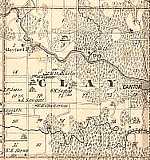 From A. T. Andreas' Illustrated Historical Atlas of Iowa, by Alfred Theodore Andreas, Chicago, Andreas Atlas Co., 1875, page 157. Printed by Lakeside Press, Chicago.
From A. T. Andreas' Illustrated Historical Atlas of Iowa, by Alfred Theodore Andreas, Chicago, Andreas Atlas Co., 1875, page 157. Printed by Lakeside Press, Chicago. |
CLAY TOWNSHIP
 Clay is one of the oldest-settled townships in the county. The first permanent settlers were David Killam, John E. Holmes, Benjamin Collins, Truman Brown and Madison Brown, who were here before 1838. John E. Lovejoy, now of Scotch Grove, came in 1839; P. D. Turner and Horace Turner came the same year, and, in the following spring, Lyman Turner, the father of P. D. and Horace. From 1840 to 1850, a few settlers came in, but in the latter year, the tide of emigrants which came pouring West, reached that place, and Clay Township was rapidly settled from that time on. A small portion of the village of Canton is in this township, and Canton may be called the commercial center. In early years, considerable lumber was manufactured at Canton. The South Fork of the Maquoketa enters the township at the northwest corner, and crossing to the east, leaves the township at the village of Canton. Along the river there is a good body of timber. The land along the river is a good deal broken and some of it rather sandy, but where it can be tilled gives good crops. Mineral Creek runs through the township near the south side, entering it near the north line of Section 31, and leaving it about a mile and a half north of the southeast corner of the township. The land in the prairie districts is abundantly productive, and the township is well watered and timbered. Clay is one of the oldest-settled townships in the county. The first permanent settlers were David Killam, John E. Holmes, Benjamin Collins, Truman Brown and Madison Brown, who were here before 1838. John E. Lovejoy, now of Scotch Grove, came in 1839; P. D. Turner and Horace Turner came the same year, and, in the following spring, Lyman Turner, the father of P. D. and Horace. From 1840 to 1850, a few settlers came in, but in the latter year, the tide of emigrants which came pouring West, reached that place, and Clay Township was rapidly settled from that time on. A small portion of the village of Canton is in this township, and Canton may be called the commercial center. In early years, considerable lumber was manufactured at Canton. The South Fork of the Maquoketa enters the township at the northwest corner, and crossing to the east, leaves the township at the village of Canton. Along the river there is a good body of timber. The land along the river is a good deal broken and some of it rather sandy, but where it can be tilled gives good crops. Mineral Creek runs through the township near the south side, entering it near the north line of Section 31, and leaving it about a mile and a half north of the southeast corner of the township. The land in the prairie districts is abundantly productive, and the township is well watered and timbered.
 Taken as a whole, Clay compares favorably with other townships of the county. Taken as a whole, Clay compares favorably with other townships of the county. |
|
| BETHEL PRESBYTERIAN CHURCH
 This Church was organized June 14, 1870, at the schoolhouse in the southwest quarter of Clay Township, by a committee of the Dubuque Presbytery. The committee consisted of Revs. S. Hodge, D. D., J. L. Wilson and Elder Judge McKean. Previous to the year 1861, Rev. George E. Delavan, of Wyoming, had preached in this neighborhood, and on his death, which took place that year, Rev. James L. Wilson, of Scotch Grove, was invited and continued to preach at the Paul Schoolhouse in Wyoming Township, every two weeks, from June 16, 1861, till the close of 1872. In 1865, these services were held in the Paul Schoolhouse, Clay Township, and the Lord's Supper was administered frequently here, the Elders of Scotch Grove assisting, with which Church the most of the brethren in this neighborhood had united. This Church was organized June 14, 1870, at the schoolhouse in the southwest quarter of Clay Township, by a committee of the Dubuque Presbytery. The committee consisted of Revs. S. Hodge, D. D., J. L. Wilson and Elder Judge McKean. Previous to the year 1861, Rev. George E. Delavan, of Wyoming, had preached in this neighborhood, and on his death, which took place that year, Rev. James L. Wilson, of Scotch Grove, was invited and continued to preach at the Paul Schoolhouse in Wyoming Township, every two weeks, from June 16, 1861, till the close of 1872. In 1865, these services were held in the Paul Schoolhouse, Clay Township, and the Lord's Supper was administered frequently here, the Elders of Scotch Grove assisting, with which Church the most of the brethren in this neighborhood had united.
 April 27, 1870, a petition was sent by these friends to the Presbytery and a committee appointed as above stated, who, in company with Revs. H. N. Potter, of Epworth, Moderator, and Justus L. Janes, of Wyoming, met as stated, on the 16th of June, 1870, and organized Bethel Presbyterian Church, of Clay Township. April 27, 1870, a petition was sent by these friends to the Presbytery and a committee appointed as above stated, who, in company with Revs. H. N. Potter, of Epworth, Moderator, and Justus L. Janes, of Wyoming, met as stated, on the 16th of June, 1870, and organized Bethel Presbyterian Church, of Clay Township.
 Andrew Scroggie and Stephen R. Streeper were chosen Elders, and ordained and installed by the committee. Andrew Scroggie and Stephen R. Streeper were chosen Elders, and ordained and installed by the committee.
 Arrangements were also made to build a church edifice, but as soon after a Church was formed in Onslow, agreement was made with the Free-Will Baptist Church in Clay, to have services in their church, which has been continued till the present time. A charter and by-laws were adopted and legally executed December 17, 1870. Arrangements were also made to build a church edifice, but as soon after a Church was formed in Onslow, agreement was made with the Free-Will Baptist Church in Clay, to have services in their church, which has been continued till the present time. A charter and by-laws were adopted and legally executed December 17, 1870.
 On January 13, 1873, Rev. J. L. Wilson resigned the pastoral charge of this Church, and, on May 25, Rev. John Rice preached and was invited to return and has since continued to preach to this Church in connection with Scotch Grove. On January 13, 1873, Rev. J. L. Wilson resigned the pastoral charge of this Church, and, on May 25, Rev. John Rice preached and was invited to return and has since continued to preach to this Church in connection with Scotch Grove.
 On June 16, 1877, a congregational meeting was held, Rev. John Rice presiding, at which time it was resolved to adopt the limited term of office for the Elders and Deacons, whereby each is to serve three years; and the following were chosen as Elders: Andrew Scroggie, Stephen R. Streeper, Andrew Duncanson and Thomas Hamilton; and as Deacons, A. P. Ornsby, John Dennison and David H. Orr, and on November 4, they were duly installed. On June 16, 1877, a congregational meeting was held, Rev. John Rice presiding, at which time it was resolved to adopt the limited term of office for the Elders and Deacons, whereby each is to serve three years; and the following were chosen as Elders: Andrew Scroggie, Stephen R. Streeper, Andrew Duncanson and Thomas Hamilton; and as Deacons, A. P. Ornsby, John Dennison and David H. Orr, and on November 4, they were duly installed.
 This Church, at its yearly meeting, January 8, 1879, gave strong expression to the principles of the Presbyterian Church, on subjects of temperance and dancing. This Church, at its yearly meeting, January 8, 1879, gave strong expression to the principles of the Presbyterian Church, on subjects of temperance and dancing.
 Officers, 1879: John Orr, Chairman; John Dennison, Secretary; A. P. Ornsby, Treasurer. Officers, 1879: John Orr, Chairman; John Dennison, Secretary; A. P. Ornsby, Treasurer. |
|
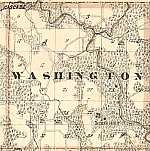 From A. T. Andreas' Illustrated Historical Atlas of Iowa, by Alfred Theodore Andreas, Chicago, Andreas Atlas Co., 1875, page 157. Printed by Lakeside Press, Chicago.
From A. T. Andreas' Illustrated Historical Atlas of Iowa, by Alfred Theodore Andreas, Chicago, Andreas Atlas Co., 1875, page 157. Printed by Lakeside Press, Chicago. |
WASHINGTON TOWNSHIP
 There are but few counties in which there is no Washington Township, and Jones County is no exception to the rule. This is the northeast township of the county, and is one of the first settled portions in it. The north fork of the Maquoketa River enters the northeast corner, crosses to the southeast and leaves the township about a half-mile north of the southeast corner. The Whitewater branch of the Maquoketa enters the township from the north, a mile west of the northeast corner, and unites with the latter in the north part of Section 10. Farm Creek crosses the southwest portion, and, entering Clay Township on the south, empties into the south fork of the Maquoketa a little north of the center of that township. There are but few counties in which there is no Washington Township, and Jones County is no exception to the rule. This is the northeast township of the county, and is one of the first settled portions in it. The north fork of the Maquoketa River enters the northeast corner, crosses to the southeast and leaves the township about a half-mile north of the southeast corner. The Whitewater branch of the Maquoketa enters the township from the north, a mile west of the northeast corner, and unites with the latter in the north part of Section 10. Farm Creek crosses the southwest portion, and, entering Clay Township on the south, empties into the south fork of the Maquoketa a little north of the center of that township.
 The surface of Washington is quite broken and hilly, and a large portion is timber-land. The soil, when cultivated, is productive, and the settlers are mostly Irish. Among the pioneers in this township were C. P. Hutton, who was one of the first Board of County Commissioners, as is stated elsewhere; James Hutton, the son of C. P. Hutton, who now resides in Scotch Grove Township; Abraham Hostetter and a Mr. Mefford. These settlers there about 1836 or 1837. William Radford, Mahlon Lupton, William Rafferty and George Banghart, came and settled in Washington, not far from the same time. A portion of the city of Cascade is in the northwest corner of this township and in the northeast corner of Richland, but the greater portion is in the county of Dubuque, and Cascade is properly a Dubuque County city. The surface of Washington is quite broken and hilly, and a large portion is timber-land. The soil, when cultivated, is productive, and the settlers are mostly Irish. Among the pioneers in this township were C. P. Hutton, who was one of the first Board of County Commissioners, as is stated elsewhere; James Hutton, the son of C. P. Hutton, who now resides in Scotch Grove Township; Abraham Hostetter and a Mr. Mefford. These settlers there about 1836 or 1837. William Radford, Mahlon Lupton, William Rafferty and George Banghart, came and settled in Washington, not far from the same time. A portion of the city of Cascade is in the northwest corner of this township and in the northeast corner of Richland, but the greater portion is in the county of Dubuque, and Cascade is properly a Dubuque County city.
 The early history of this township is more or less identical with that of Richland, and is given in a chapter by Barrett Whittemore. The early history of this township is more or less identical with that of Richland, and is given in a chapter by Barrett Whittemore. |
|

![[space]](graphics/space.gif)

![[space]](graphics/space.gif)

![[space]](graphics/space.gif)
![[to home]](../shared/homepage.gif)
![[space]](graphics/space.gif)

© Copyright 1997-2013, The Art Department, © Copyright 2014-2020, Richard Harrison.
Last updated on Friday, 16-Apr-2021 16:54:39 MST
|
|





 The
The


 From A. T. Andreas' Illustrated Historical Atlas of Iowa, by Alfred Theodore Andreas, Chicago, Andreas Atlas Co., 1875, page 157. Printed by Lakeside Press, Chicago.
From A. T. Andreas' Illustrated Historical Atlas of Iowa, by Alfred Theodore Andreas, Chicago, Andreas Atlas Co., 1875, page 157. Printed by Lakeside Press, Chicago. From A. T. Andreas' Illustrated Historical Atlas of Iowa, by Alfred Theodore Andreas, Chicago, Andreas Atlas Co., 1875, page 157. Printed by Lakeside Press, Chicago.
From A. T. Andreas' Illustrated Historical Atlas of Iowa, by Alfred Theodore Andreas, Chicago, Andreas Atlas Co., 1875, page 157. Printed by Lakeside Press, Chicago.



